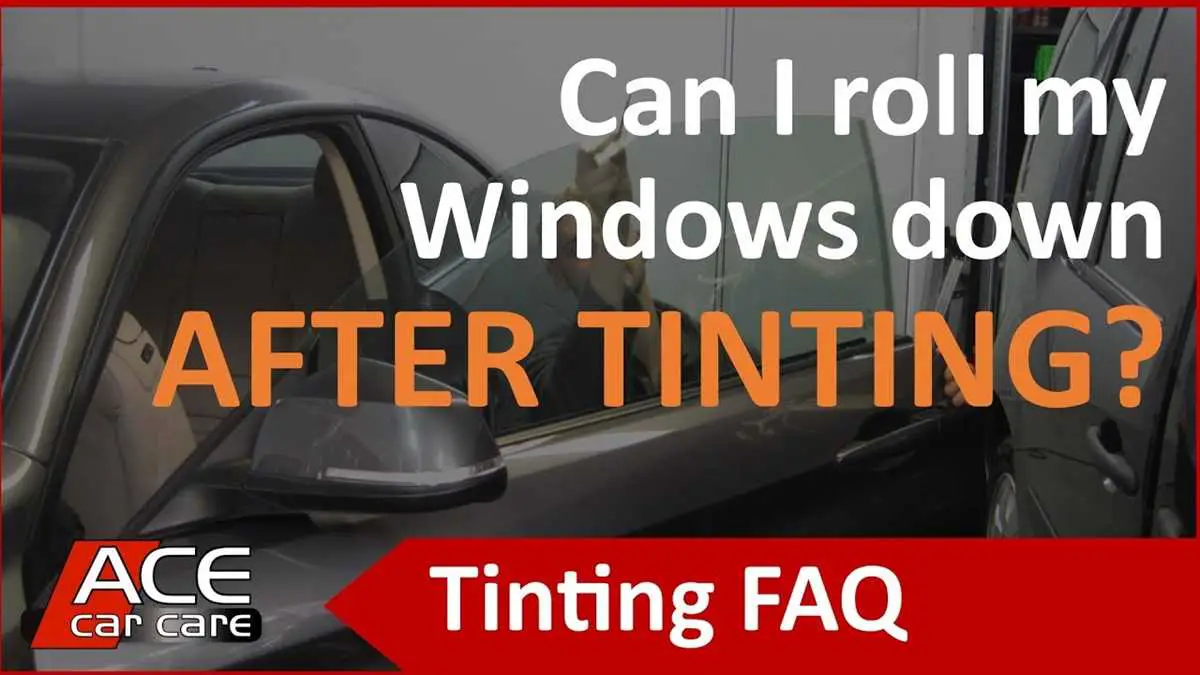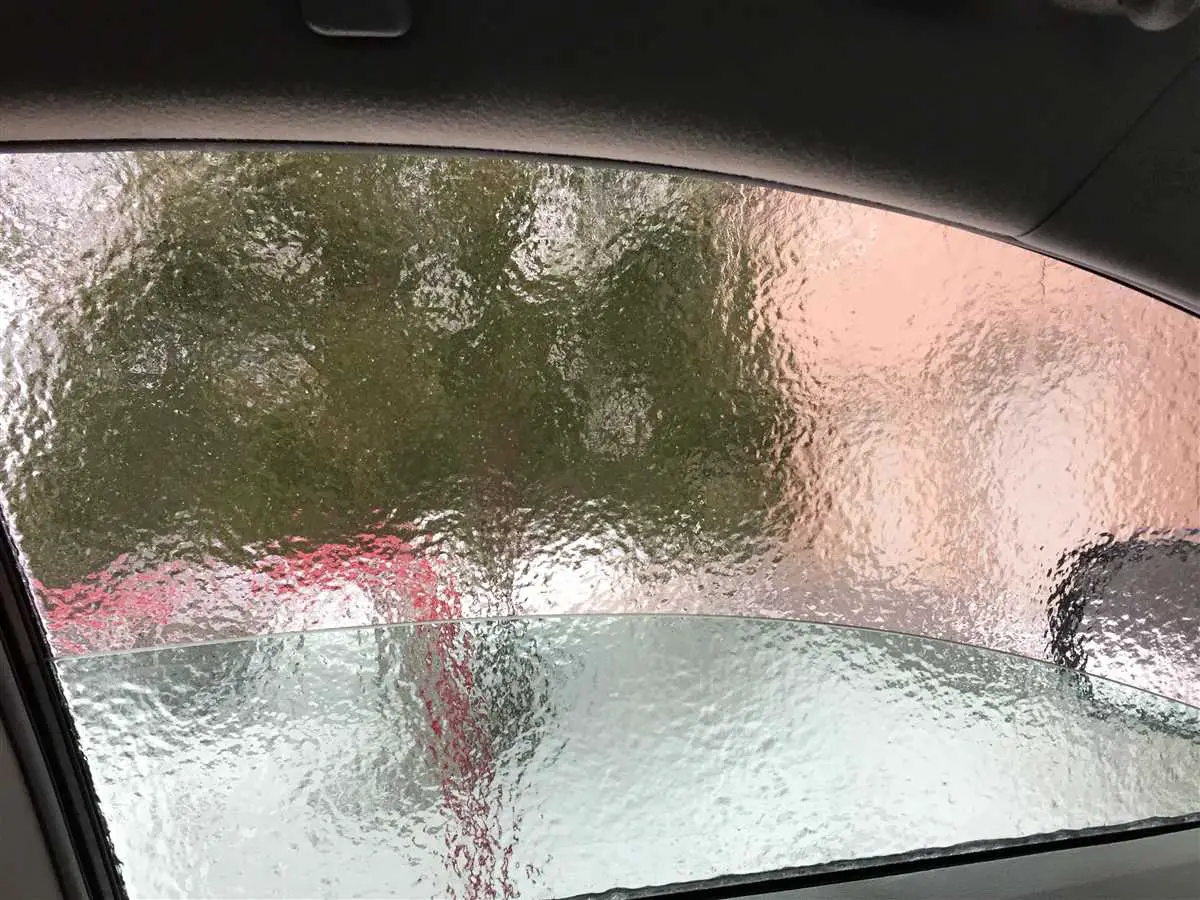Last Updated on February 5, 2024 by Vadym

Window tinting is a popular way to enhance the look and functionality of a vehicle. It provides privacy, reduces glare, and blocks harmful UV rays. However, many people wonder what happens if they roll their window down after getting it tinted. Is it safe? Will it damage the tint?
The short answer is that rolling down your window immediately after tinting can cause the tint to peel or bubble. This is because the tint needs time to fully adhere to the glass. Rolling down the window too soon can disrupt this process and lead to unsightly and costly damage.
It is recommended to wait at least 48 hours before rolling down your tinted windows. This allows the tint to fully cure and ensures that it will adhere properly. While it may be tempting to roll down the window to enjoy the fresh air or show off your new tint, it is best to be patient and wait for the proper curing time.
The Effects of Rolling Down Your Window After Tint
Window tinting is a popular choice for vehicle owners who want to enhance privacy, reduce heat, and protect the interior from harmful UV rays. However, many car owners wonder what will happen if they roll down their windows after getting the tint applied.
Rolling down your window after tint can have a few effects on the tint itself. First and foremost, it can cause the tint to peel or bubble. This is especially true if you roll the window down too soon after getting it tinted. Tint needs time to fully adhere to the glass, and rolling down the window too early can disrupt this process and cause the tint to separate from the surface.
Another effect of rolling down your window after tint is a potential decrease in the tint’s effectiveness. Tinted windows block a significant amount of heat and UV rays, but when you roll down the window, you’re letting in outside air and potentially harmful UV rays. This can reduce the overall effectiveness of the tint in keeping your car cool and protecting your skin from UV damage.
Additionally, rolling down your window after tint can increase the likelihood of scratches and damage to the tint itself. Dust, dirt, and debris can enter the window when it’s rolled down, and these particles can scratch or damage the tinted surface. It’s important to keep the windows closed for a few days after getting tint to allow the tint to fully cure and reduce the risk of damage.
If you absolutely need to roll down your window after getting tint, it’s recommended to wait at least a few days to ensure the tint has properly cured and adhered to the glass. This will minimize the risk of peeling, bubbles, and scratches. Additionally, consider using a sunshade or window visor to further protect your tinted windows from direct sunlight and potential damage.
In conclusion, rolling down your window after tint can have negative effects on the tint itself, such as peeling, reduced effectiveness, and potential scratches. It’s important to follow the recommended guidelines and wait for the tint to fully cure before rolling down your windows to minimize these risks. Taking proper care of your tinted windows will ensure they last longer and maintain their desired appearance.
How Rolling Down Your Window Can Damage Your Tint
Rolling down your window after tinting it can potentially lead to damage to your tint film. Tint film is typically applied to the inside of your car’s windows as a way to reduce heat and glare, as well as increase privacy. While tint film is designed to be durable, it is still susceptible to damage from various factors, including rolling down your window.
When you roll down your window, the tint film can rub against the rubber seals and trim surrounding the window. This friction can cause the tint film to peel, bubble, or even scratch. Over time, continuous rolling down of the window can worsen the damage, leading to the need for repairs or a complete replacement of the tint.
Additionally, rolling down your window can also expose the tint film to moisture. If you roll down your window when it’s raining or when there is dew or condensation on the glass, water can seep into the edges of the tint film. This moisture can cause the tint film to peel away from the glass or create bubbles, compromising its effectiveness and appearance.
It’s important to note that the extent of the damage may vary depending on the quality of the tint film and the installation. Cheaper or lower-quality tint films are more prone to damage, while high-quality films are designed to be more durable and resistant to peeling and bubbling.
To avoid damaging your tint film, it is recommended to wait at least 48 hours before rolling down your windows after tinting. This allows the tint film to fully adhere to the glass and minimize the risk of damage. Additionally, when rolling down your windows in the future, do so carefully and avoid excessive force or rubbing against the tint film. It’s also a good idea to regularly clean the windows and tint film using a non-abrasive cleaning solution and a soft microfiber cloth to prevent dirt and debris from causing damage.
| Rolling Down Your Window | Potential Damage to Tint |
| Rubbing Against Rubber Seals and Trim | Peeling, bubbling, and scratching of the tint film |
| Exposing to Moisture | Peeling, bubbling, and compromised effectiveness of the tint film |
The Risk of Peeling and Bubbling
When you roll your window down after having your tinted windows installed, you run the risk of peeling and bubbling. This is because the adhesive used to apply the tint needs time to fully bond to the glass. Rolling the window down too soon can disrupt this bonding process and cause the tint film to peel or bubble.
Peeling occurs when the tint film starts to detach from the glass. This can happen if the adhesive hasn’t fully adhered to the surface or if there is any debris or residue on the glass that prevents proper bonding. Once peeling starts, it can continue to worsen over time, leaving unsightly gaps and exposing your windows.
Bubbling, on the other hand, is caused by air or moisture getting trapped between the tint film and the glass. When you roll your window down, it creates pressure that can push air or moisture into the small gaps between the film and the glass. As a result, bubbles begin to form and can grow in size over time. Not only do they look unattractive, but they can also obstruct your view and affect the overall performance of your tint.
To avoid the risk of peeling and bubbling, it’s essential to follow the manufacturer’s instructions regarding the curing time for your specific tint. This typically ranges from a few days to a week. During this period, it’s best to keep your windows rolled up and avoid any contact that may disturb the bonding process.
If you’ve already rolled your window down too soon and notice peeling or bubbling, it’s important to address the issue promptly. Contacting a professional tint installer can help assess the damage and provide a solution, such as reapplying the tint or repairing any visible flaws.
In conclusion, rolling your window down too soon after tinting poses the risk of peeling and bubbling. To avoid these issues, make sure to allow the adhesive enough time to fully bond to the glass before operating your windows. By following the proper curing time and taking necessary precautions, you can enjoy your tinted windows without worrying about unsightly peeling or bubbling.
The Impact on UV Protection
Window tint is designed to block harmful ultraviolet (UV) rays from entering your vehicle. UV rays can cause damage to your skin and eyes, and they can also fade and damage the interior of your car.
However, rolling down your window after tinting can have a negative impact on the UV protection provided by the tint. When you roll down your window, you are allowing more sunlight and UV rays to enter your vehicle, which can diminish the effectiveness of the tint.
Additionally, rolling down your window can also increase the risk of fading and damage to the interior of your car. The UV rays that are able to enter your vehicle can lead to the fading of upholstery, dashboard, and other interior components.
If you need to roll down your window after tinting, it is recommended to do so with caution and be mindful of the potential impact on UV protection. Consider using additional measures, such as sunscreen or window shades, to help mitigate the effects of increased sunlight and UV rays.
Overall, while window tint can provide significant UV protection when the windows are closed, rolling down your window after tinting can reduce this protection and increase the risk of damage to your vehicle’s interior. It is important to consider these factors before making the decision to roll down your tinted windows.
The Importance of Proper Window Care

Proper care and maintenance of your car’s windows are essential for ensuring their longevity and functionality. Whether you have tinted windows or not, taking care of your windows can save you from costly repairs and replacements in the long run.
One of the primary reasons for maintaining your car’s windows is to prevent scratches and damage. Window tinting film can be susceptible to scratches, especially if you roll down your windows without caution. It is important to be mindful of this and handle your windows with care.
Regular cleaning is another crucial aspect of window care. Dirty windows not only obstruct your view but can also lead to damage over time. Dust, dirt, and debris can accumulate on the surface of the window, causing scratches and reducing visibility. Regularly cleaning your windows with a mild glass cleaner and a soft, non-abrasive cloth can help prevent such issues.
Furthermore, protecting your windows from extreme temperatures can significantly contribute to their durability. In hot weather, it is advisable to park your car in shaded areas or use sunshades to minimize heat buildup, as excessive heat can cause the tint film to peel or bubble. Similarly, in winter, avoid using hot water to deice your windows, as the sudden temperature change can result in cracking.
In addition to these preventive measures, it is essential to address any damages promptly. If you notice any cracks, chips, or peeling in the tint film, it is best to consult a professional for repairs or replacements. Ignoring such issues can lead to further damage and compromise the effectiveness of the tint in providing privacy and blocking UV rays.
In conclusion, proper window care is crucial for maintaining the longevity and functionality of your car’s windows, whether they are tinted or not. By following simple preventive measures such as handling with care, regular cleaning, and protecting from extreme temperatures, you can extend the lifespan of your windows and avoid expensive repairs down the line.
Finding a Solution for Rolled Down Windows
If you have accidentally rolled down your tinted windows, don’t panic. There are a few solutions you can try to fix the issue:
- Call a Professional: If you are unsure about how to fix the problem yourself, it is best to call a professional window tinting service. They have the expertise and tools needed to safely and effectively fix rolled down tinted windows.
- Use Protective Film: If the window tint has peeled or is damaged, you can temporarily cover the window with protective film. This will help prevent further damage and protect your privacy until you can get the tint repaired or replaced.
- Consult the Tint Manufacturer: If you know the brand of tint used on your windows, contact the manufacturer for guidance on fixing rolled down windows. They may have specific recommendations or instructions for repairing their product.
- Prevent it from Happening Again: To avoid future accidents, make sure to educate yourself on the proper operation and maintenance of tinted windows. Be cautious when rolling down the windows and avoid applying excessive force.
Remember, it is crucial to address the issue as soon as possible to prevent further damage and ensure the longevity of your window tint.
